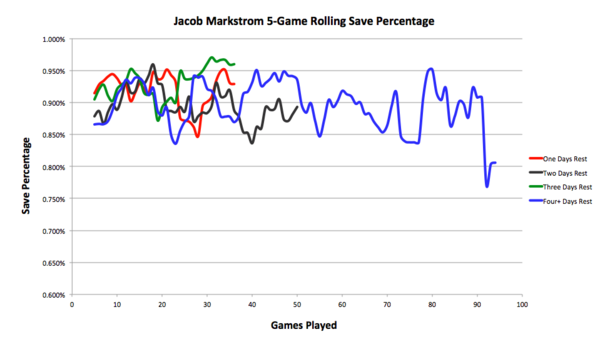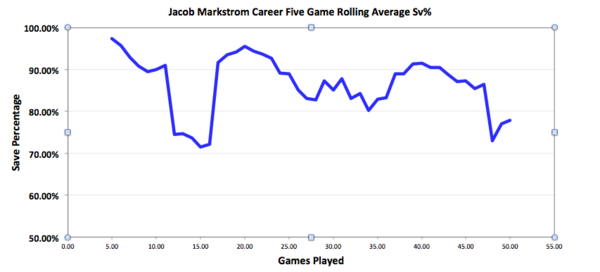Is Jacob Markstrom a Rhythm Goaltender?
By J.D. Burke
8 years agoI can’t remember as perplexing a goaltending prospect as Jacob Markstrom. Once considered the best goaltending prospect the league had to offer, his star has since fallen to that of a project, backup goaltender at the age of 25-years old.
The lanky, Swedish netminder has excelled at every professional level he’s plied his trade at, save for the NHL. Explanations vary but range anywhere from a lack of mobility to performance anxiety. Whatever the case, Markstrom’s results haven’t been overly flattering and it’s safe to say at this point that his NHL career is pushed to the brink.
I can’t offer any insight into what the future holds, but I’ve a pet theory as to why Markstrom has struggled at the NHL level thus far. One I will try to do justice, on the other side of the jump.
What is a Rhythm Goaltender
Believe it or not, I not only used to play hockey… but I was a goalie for a few years, even. Well, I did something that resembled goaltending, anyways. There was nothing I dreaded more than extended stretches of play without any sort of action. I have trouble focusing at the best of times, but yeesh, you give me five minutes with which to roam mentally and I’m already thinking about my plans for the weekend.
On an entirely related note, I was never all that good and my career never advanced beyond house leagues and pick-up.
There’s a point to all this. There are some goaltenders who need to get into the flow of the game early, otherwise they run the risk of performing nowhere near their best level. To some extent, I think that Roberto Luongo was on this wavelength; Ryan Miller almost certainly is. It’s a detriment, insofar as it leaves the netminder in question predisposed to some goals they really want back. On the bright side, should they get into a groove early enough, good luck getting anything past them.
“To a certain degree, every goaltender relies on rhythm and timing to feel good. The question is: to what degree. Ryan Miller is what we talk about being a rhythm goaltender.”
As it Pertains to Jacob Markstrom
There isn’t any real consensus on Markstrom as a rhythm goaltender among the goaltender minds I’ve pried. They each have a unique take on Markstrom’s game and this theory on the whole, but none seem to be overly convinced of this theory.
I first asked friend and occasional contributor to the Army, Catherine Silverman, for her thoughts on the topic – she qualified this statement by suggesting that goaltenders, in general, are voodoo.
I think it’s entirely possible, although I can’t say I’ve looked into this theory too much myself. In all likelihood, Markstrom would benefit from an increased workload at the NHL, if for no other reason than he’d be given a chance to step out from Ryan Miller’s shadow.
I then pried the mind of upstart goaltending mind, contributor to InGoal Magazine and master of the .gif laden tweet, Greg Balloch…
I’m not sure I would agree with the theory that Jacob Markstrom is a rhythm based goaltender. He has (reluctantly) added some blocking elements to his game in recent years because of his tendency to rely on his athleticism too much. Being a step behind plays and reaching was his main issue during his struggles last season. The problem is, he liked to play that way. When you’re 6-foot-6 and you reach, the holes that open up are massive. NHL shooters will pick you apart.
And here are Woodley’s thoughts (from the same podcast I linked to above) on the possibility of Markstrom matching up as a rhythm goaltender in general…
I would say that Markstrom doesn’t fit that; I don’t think of him as a rhythm goaltender. And certainly, I think of him as less of a rhythm goaltender since they made these adjustments in his positioning. In other words: stay at home, play it neutral, play it square and rely less than you used to on your reads and challenging aggressively in certain situations because of these reads.”
What Do the Numbers Say?
Intuitively, one would assume that a heavier workload would allow a goaltender to get into a better groove. There are other factors to consider, like the time between each shot and the danger level etc., but at its most base level, this theory makes sense. Certainly passes the sniff test, anyways. Looking at the bigger picture, it also makes intuitive sense that a goaltender whose game is predicated on rhythm would perform better with less time between starts.
There are legitimate reasons for skepticism when approaching the shot based approach to gauging rhythm. Chief among them are the fact that sv% is volatile at the best of times, but especially so in smaller samples. To be convinced by this metric, the difference in performance between shot distribution would have to be stark enough to not just be noise.

In this most rudimentary of data sets, we find that it checks out in almost every regard. This is based on his performance over a five-year sample of professional hockey in North America. The difference between sv% is also so noticeably stark that it alludes there might be something worth looking into at a more granular level.

It has been shown on numerous occasions that goaltenders performance is affected positively by rest. It’s why the analytics community is so diametrically opposed to starting goaltenders in the second half of back-to-backs. Of course, there are exceptions to any rule though and it appears as though Markstrom might fit the bill.
Another area worth looking at is the goaltenders sv% by distribution of danger level, by shot. For this exercise, the AHL data comes out of the equation – their data sets don’t expand very far, at all. I feel as though this is one area which might be more subject to the eye of the beholder when determining the signal from the noise. That said, I’m of a firm belief that getting into a rhythm requires a high volume of shots, rather than quality.

The signal isn’t overly revealing, but what stands out most is the fact that Markstrom has rarely, if ever, been at the NHL average for sv% on high-danger shots. On low-danger, however, he appears to be a borderline competent NHL netminder. Something which runs entirely contrary to everything we know about Markstrom with less focused data…

Closing Thoughts
With my swath of charts and personal experience alike, I can’t profess to offer half of the insight into the position of goaltending as some of the sources quoted in this article. These are some of the brightest minds that positional analysis has to offer, so it’s quite likely that they’re entirely right and Markstrom either isn’t a rhythm goaltender or is straying from that element of his game.
All the same, there’s a pretty reasonable case to be made that Markstrom benefits from an increased workload. It would certainly explain why he’s struggled to establish himself as an NHL backup and only ever showed as quasi-competent in a brief stretch as a starter.
If anything, it adds to the many reasons for pause with regards to how he’ll perform in his prescribed role this season. I would like to think that he’s up to the task, but it seems fair to wonder how well he’ll perform if they put him on the Eddie Lack diet for starts; one which allows about one every third week of action behind a healthy Miller.
Similarly, Miller should watch over his shoulders should the schedule allow for an extended look at Markstrom. Should Markstrom find that groove, good luck getting him out of it.
Recent articles from J.D. Burke





